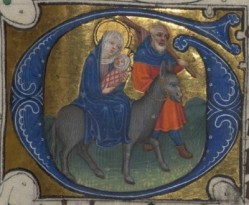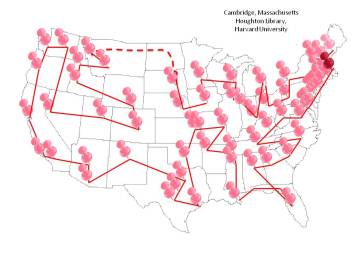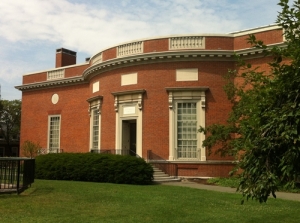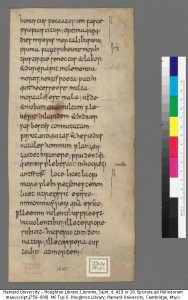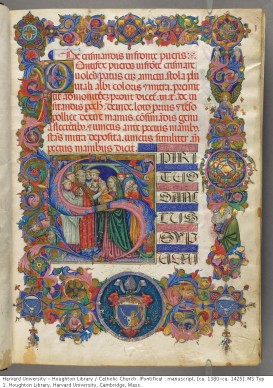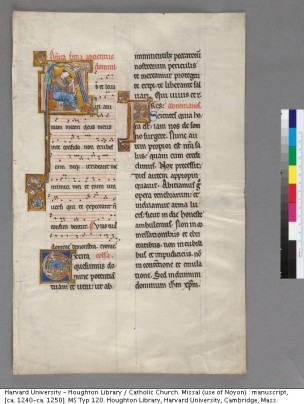As of now, I have “visited” every state in the continental U.S., and in only one – North Dakota – have I not found a single medieval leaf or codex. Canada’s next, but before I virtually head up to Nova Scotia, I’m going to write one more post from my hometown of Boston, about the collection that lies within a stone’s throw of my Medieval Academy office: the Houghton Library at Harvard University.
Harvard has been acquiring manuscripts since the early nineteenth century. The first manuscripts to arrive were seven codices (six Greek and one Latin) given by Edward Everett in 1819; in 1874, Charles Sumner gave twenty-six medieval manuscripts to the University. The first purchases were seven manuscripts bought at the 1896 Phillipps sale at Sotheby’s, and the collection has grown from there. For more on the early development of the collection, see pp. xii-xiv of Laura Light’s 1995 Catalogue of medieval and renaissance manuscripts in the Houghton Library, Harvard University.
According to the Houghton website, Harvard was the first American institution to construct a separate building for its rare material, opening the Houghton Library in 1942. With the foundational collection supplemented by purchases and bequests, including the acquisition of collections compiled by William K. Richardson and Philip Hofer, the Houghton Library currently houses more than 1,000 codices and leaves, including some of the earliest medieval material in North America.
Today, the Houghton collection runs the gamut, from early fragments included in E. A. Lowe’s classic Codices Latini antiquiores to Carolingian leaves studied by Bernhard Bischoff, through every genre and era to major masterpieces of Renaissance manuscript and incunable illumination. Manuscripts from the collections of some of the most important scriptoria, patrons, and collectors have found their way into Houghton, from Tours and Montecassino to Jean, Duc de Berry and Sir Thomas Phillipps.
Nearly every major project on which I have worked in my career has had a Houghton connection: in the reading room, I have examined two leaves of the Gottschalk Antiphonal (the subject of my doctoral dissertation and first book), two copies of the Chronique Anonyme Universelle (here and here), and, most recently, two leaves of the Beauvais Missal. I’ve consulted the notes compiled by William H. Bond as he prepared his Supplement to the de Ricci Census, and I’ve spent more hours than I care to admit searching through Houghton’s vast auction and sales catalogue collection for provenance information on particular manuscripts in U.S. collections. The Houghton collection is so vast and varied that, whatever topic you are working on, you will always find something of interest, and the incredibly knowledgeable curators and reading room staff are always ready to help you find what you seek. Be sure to schedule your research to include working on a Friday, when readers join curators and reading room staff mid-morning for coffee and cookies.
As helpful as the staff is, you will not need their assistance to consult the vast amount of information about the collection and its holdings that is now available online. There are three online access points for the manuscripts: HOLLIS (MARC records in Harvard’s OPAC), the Digital Medieval Manuscripts collection, and the external database Digital Scriptorium (all images open access). Each point of access requires a different search strategy and offers a slightly different type of data (detailed metadata, digital surrogates, and selected images, respectively), so you should choose your access depending on your particular needs. Search strategies for HOLLIS and the Digital Medieval Manuscripts databases can be found here. If you know the shelfmark of the manuscript in which you are interested, the best place to start is the Digital Medieval Manuscripts collection. From the Manuscript Collections page, click on the shelfmark prefix (MSS Lat, MSS Ger, or MSS Typ, for example) and then scroll down to the manuscript you are looking for. There you will find links to the digital surrogate (if available) and a detailed bibliography, both of which also link to the HOLLIS record. William P. Stoneman, Curator of Early Books and Manuscripts, is particularly interested in keeping the bibliographies up-to-date and asks that you please contact him with additional references to particular manuscripts. Digitization is ongoing, so if the manuscript you’re looking for hasn’t been digitized yet, it is probably in the queue and will be available soon.
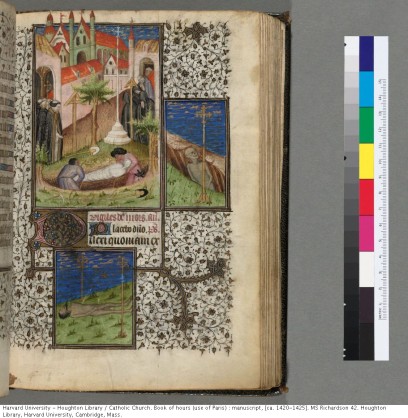
Houghton, MS Richardson 42 (“The De Buz Hours”), f. 118, the Office of the Dead (France, ca. 1420-25)
I’ll use a recently-digitzed masterpiece, the De Buz Hours (a.k.a. MS Richardson 42), as an example. The HOLLIS record provides authority-controlled metadata pertaining to the contents, codicological structure, binding, script, illumination, and provenance, among other MARC/AMREMM fields. On the Digital Medieval Manuscripts page, you will find links to a detailed bibliography as well as a full, open-access digital surrogate. Meanwhile, over at Digital Scriptorium, you will find selected open-access images as well as codicological and descriptive metadata in an image databank that includes dozens of other collections.
Other online resources include a project devoted to Books of Hours titled Picturing Prayer, the Houghton blog, and a tumblr.
Several other Harvard collections also house early manuscripts: the Andover-Harvard Theological Library, Harvard Medical School, Harvard Law School, and Harvard Business School. Some of this material can be found in HOLLIS or via the collections’ websites.
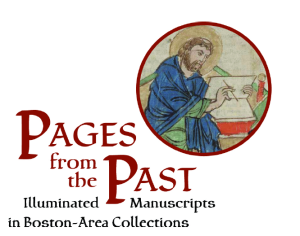 Much of the cataloguing and digitization currently underway at Houghton is in preparation for the 2016 exhibit Pages from the Past that will showcase more than 250 pre-1600 manuscripts and incunables from Boston-area collections. The Houghton Library will serve as one of three exhibition venues (parts of the exhibit will also be installed at the McMullen Museum at Boston College and the Isabella Stewart Gardner Museum) but will also be the major lender, contributing more than half of the exhibited items. The project was recently awarded a major grant from the National Endowment for the Humanities that, combined with other sources of support, will allow the co-curators (Jeffrey Hamburger, William P. Stoneman, Anne-Marie Eze, Nancy Netzer, and myself) to fully realize our vision of a pedagogically sound exhibit accompanied by a detailed catalogue, scholarly colloquium, significant public programming, and full digitization and online availability of every item in the show. The exhibit will open in September 2016. I hope you will have the chance to come to Boston and see these treasures for yourself.
Much of the cataloguing and digitization currently underway at Houghton is in preparation for the 2016 exhibit Pages from the Past that will showcase more than 250 pre-1600 manuscripts and incunables from Boston-area collections. The Houghton Library will serve as one of three exhibition venues (parts of the exhibit will also be installed at the McMullen Museum at Boston College and the Isabella Stewart Gardner Museum) but will also be the major lender, contributing more than half of the exhibited items. The project was recently awarded a major grant from the National Endowment for the Humanities that, combined with other sources of support, will allow the co-curators (Jeffrey Hamburger, William P. Stoneman, Anne-Marie Eze, Nancy Netzer, and myself) to fully realize our vision of a pedagogically sound exhibit accompanied by a detailed catalogue, scholarly colloquium, significant public programming, and full digitization and online availability of every item in the show. The exhibit will open in September 2016. I hope you will have the chance to come to Boston and see these treasures for yourself.

